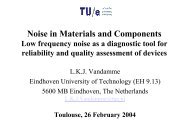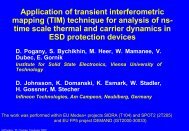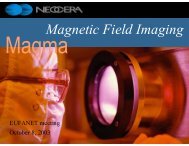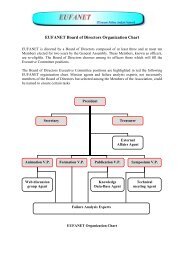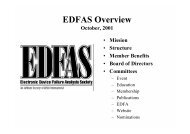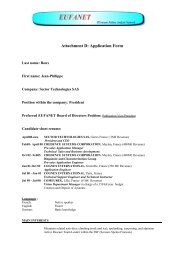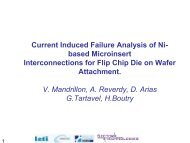3D Localization by Lock-in Thermography - eufanet
3D Localization by Lock-in Thermography - eufanet
3D Localization by Lock-in Thermography - eufanet
- No tags were found...
Create successful ePaper yourself
Turn your PDF publications into a flip-book with our unique Google optimized e-Paper software.
<strong>3D</strong> LOCALIZATION BY<br />
LOCK-IN THERMOGRAPHY<br />
EUFANET – Toulouse – November 2011<br />
Sherm<strong>in</strong> Danaie - Master1 EEATS at Joseph Fourier University Grenoble<br />
Quent<strong>in</strong> Saulnier – STMicroelectronics Grenoble – Failure Analysis<br />
Arnaud Loubaresse – STEricsson Grenoble – Failure Analysis
Purpose<br />
Increas<strong>in</strong>g functionalities <strong>in</strong><br />
mobile phone<br />
System In Package (SIP)<br />
NEW CHALLENGES:<br />
∙ Defect localization <strong>in</strong> <strong>3D</strong> (X,Y,Z) ma<strong>in</strong>ly when dices are<br />
stacked<br />
∙ Non destructive methods<br />
ONE SOLUTION:<br />
∙ Use lock-<strong>in</strong> thermography for Z location of a defect<br />
11/25/2011 CONFIDENTIAL 2
Outl<strong>in</strong>e<br />
• <strong>Lock</strong>-<strong>in</strong> thermography pr<strong>in</strong>ciple<br />
• <strong>Thermography</strong> equipment<br />
• Trial outl<strong>in</strong>e and analysis cases<br />
• Model<strong>in</strong>g for simple cases<br />
• Z measurements with Hamamatsu software<br />
• Conclusion & outlook<br />
11/25/2011 CONFIDENTIAL 3
LOCK-IN THERMOGRAPHY<br />
PRINCIPLE
<strong>Lock</strong>-<strong>in</strong> thermography pr<strong>in</strong>ciple<br />
•Two images (0° & -90°) are converted as below:<br />
Amplitude:<br />
Phase shift:<br />
∙ Phase shift is about propagation time of the wave between<br />
defect and sample surface<br />
∙ Z localization can be theorically found<br />
11/25/2011 CONFIDENTIAL 5
THERMOGRAPHY EQUIPMENT
<strong>Thermography</strong> equipment<br />
∙ Themos 1000 from Hamamatsu is used:<br />
∙ InSb detector, max efficiency between 3.7µm to 5.2µm<br />
∙ Examples of images for the 3 <strong>in</strong>frared lenses (Germanium):<br />
∙ CSP product, silicon thickness around 350µm<br />
0.8X, FOV 12mm*9mm<br />
4X, FOV 2.4mm*1.8mm 15X, FOV 0.64mm*0.48mm<br />
11/25/2011 CONFIDENTIAL 7
TRIAL OUTLINE & ANALYSIS<br />
CASES
Trial outl<strong>in</strong>e<br />
•REF unit reverse biased Diode connected to GND is polarized <strong>in</strong><br />
direct.<br />
•Reference value for phase shift measurement.<br />
•Comparison of phase shift values between REF reverse biased and<br />
FAIL units.<br />
11/25/2011 CONFIDENTIAL 9
Analysis case: back to back device<br />
Problem description and aim of analysis:<br />
bumps<br />
Digital die<br />
wire bond<strong>in</strong>g<br />
Analog die<br />
∙ Case 1: Short-circuit on digital signal<br />
∙ Case 2: Short-circuit on analog signal<br />
TRIAL OUTLINE:<br />
∙ Z localization of defect <strong>by</strong> <strong>Lock</strong>-<strong>in</strong> thermography<br />
∙ Physical characterization of defect<br />
∙ Effect of each layers on phase shift<br />
11/25/2011 CONFIDENTIAL 10
Case 1<br />
REF reverse biased, digital die:<br />
Frequency<br />
(Hz) 10 5 1<br />
Phase ( ) 180 124 60<br />
Fail<strong>in</strong>g unit:<br />
Frequency<br />
(Hz) 10 5 1<br />
Phase ( ) 188 131 68<br />
Hypothesis: Defect is located at digital die level<br />
Themos <strong>Localization</strong> Package Layout X-ray Image<br />
Defect is on wire bond<strong>in</strong>g but Z is very close to die<br />
11/25/2011 CONFIDENTIAL 11
REF reverse biased, analog die:<br />
Frequency<br />
(Hz) 10 5 1<br />
Phase ( ) 229 172 88<br />
Case 2 (1)<br />
Fail<strong>in</strong>g unit:<br />
Hypothesis: Defect is located at analog die level<br />
Frequency<br />
(Hz) 10 5 1<br />
Phase ( ) 240 180 100<br />
Effect of each material on phase shift (F lock-<strong>in</strong> = 10Hz)<br />
100° (thickness: around 140µm)<br />
50° (Process ~10µm)<br />
0° (thickness: silicon 320µm,<br />
glue)<br />
Conclusion:<br />
• Process and res<strong>in</strong> have a great <strong>in</strong>fluence on phase shift<br />
• Silicon and glue have a low <strong>in</strong>fluence on phase shift<br />
11/25/2011 CONFIDENTIAL 12
Case 2 (2)<br />
Check<strong>in</strong>g the hypothesis:<br />
<strong>Thermography</strong> of analog<br />
die after polish<strong>in</strong>g<br />
OBIRCH image<br />
Optical microscope<br />
∙ Analog die is broken<br />
∙ Remark:<br />
• Phase shift of thermal signal at defect level is not null, it’s<br />
around 35°<br />
• This is called Initial Phase Shift<br />
11/25/2011 CONFIDENTIAL 13
MODELING FOR SIMPLE CASES
Thermal wave propagation <strong>in</strong>side a solid<br />
• For isotropic and homogeneous material, Phase shift of thermal<br />
wave between defect (z=0) and surface (z=l)<br />
z=l<br />
Where<br />
µ (<strong>in</strong> mm) is called thermal diffusion length, and is depend<strong>in</strong>g on:<br />
• Thermal conductivity (λ en W/m*K)<br />
• Thermal capacity (cp en J/g*K)<br />
• Density (ρ en g/cm³)<br />
• <strong>Lock</strong>-<strong>in</strong> frequency (f en Hz)<br />
z=0<br />
11/25/2011 CONFIDENTIAL 15
Phase shift (°)<br />
Phase shift vs Z localization<br />
φ(f lock-<strong>in</strong>) for res<strong>in</strong> and silicon:<br />
Silicon<br />
Res<strong>in</strong><br />
Silicium<br />
Rés<strong>in</strong>e<br />
Frequency (Hz)<br />
• As seen dur<strong>in</strong>g trials:<br />
• Res<strong>in</strong> has a great <strong>in</strong>fluence on phase shift<br />
• Silicon has a low <strong>in</strong>fluence on phase shift<br />
11/25/2011 CONFIDENTIAL 16
Check<strong>in</strong>g model<strong>in</strong>g for Case 1<br />
• <strong>Localization</strong> of defect is close to res<strong>in</strong> thickness: Z=140µm<br />
• Res<strong>in</strong> is the only material on top of defect<br />
λ (W/m*K) cp (J/g*K) ρ (g/cm³) μ (mm)<br />
Theorical<br />
phase shift (°)<br />
at f=1Hz<br />
Experimental<br />
phase shift<br />
(°)<br />
at f=1Hz<br />
0,98 1,43 2.03 0.32 25 68<br />
But <strong>in</strong>itial phase shift has to be take <strong>in</strong>to consideration, it’s around<br />
35°.<br />
Theorical: Φ=25° Z=140µm<br />
Trial: Φ=68-35=33° Z=184µm<br />
11/25/2011 CONFIDENTIAL 17
Z MEASUREMENTS WITH<br />
HAMAMATSU SOFTWARE
Z measurements with Hamamatsu software<br />
• Need also to know characteristics below:<br />
• Thermal conductivity (λ en W/m*K), Thermal capacity (cp en<br />
J/g*K) & Density (ρ en g/cm³)<br />
Wire bonded device with 450µm of res<strong>in</strong><br />
• Works f<strong>in</strong>e for simple cases<br />
• Trials performed on <strong>3D</strong><br />
packages but accuracy is not<br />
good enough<br />
Measured:<br />
448µm<br />
11/25/2011 CONFIDENTIAL 19
CONCLUSION & OUTLOOK
Conclusion<br />
• Knowledge on:<br />
• <strong>Lock</strong>-<strong>in</strong> frequency <strong>in</strong>fluence on measurements<br />
• Low frequencies are suitable for Z localization while high<br />
frequencies are better for X/Y localization<br />
• Material <strong>in</strong>fluence on phase shift<br />
• Z localization improvement:<br />
• Relation between Z and phase shift is proven<br />
• Experimental outl<strong>in</strong>e is <strong>in</strong> place<br />
• Model<strong>in</strong>g and Z measurements are work<strong>in</strong>g for simple cases<br />
11/25/2011 CONFIDENTIAL 21
Outlook<br />
• To developed:<br />
• What about Z localization on others <strong>3D</strong> packages like face to<br />
face packages<br />
• Need to work on package description, means to know very<br />
well Thermal conductivity, Thermal capacity & Density (ρ en<br />
g/cm³)<br />
• Create a database with material characteristic<br />
• Keep strong collaboration with Hamamatsu<br />
11/25/2011 CONFIDENTIAL 22
THANK YOU






